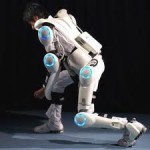Exoskeleton provides mobility to paraplegics
 By Carter Ashforth, Staff Writer
By Carter Ashforth, Staff Writer
Russ Angold, the founder and chief technology officer of Esko Bionics, recently informed the New York Times that his company has invented “the jeans of the future” in the form of an exoskeleton frame to help wounded soldiers and disabled individuals move again.
Originally designed as a robotic skeletal frame to help soldiers in the military carry up to 200 pounds across long distances, this remarkable piece of technology has turned into a groundbreaking tool for “wounded warriors with spinal cord injuries, people with multiple sclerosis, Guillain-Barre syndrome, lower extremity weakness or paralysis due to neurological disease or spinal injury,” as Allison Barrie of Fox News reports.
Esko Bionics, along with a few other companies, has essentially created wearable robots. These robots look like something out of a science-fiction film, or even the film Iron Man. These suits, designed for individuals with limited mobility, utilize a set of mechanical joints that can actually do the walking for the individual wearing it while simultaneously helping them to practice using their muscles. Researchers hope the exoskeleton will eventually replace wheelchairs and maybe even teach paraplegics to walk again. As Barrie explains, “Wheelchairs have been the go-to solution for more than 1,500 years – the 2002 census estimated 2.8 million U.S. citizens rely on them. But now, Ekso Bionics is literally revolutionizing this space. Its ultimate goal: a robot that is as easy to wear as a pair of jeans, one that requires not only innovative engineering but biomechanics advancements and cyborg-type research.” The only requirement to use an exoskeleton is the upper body strength needed to get out of a wheelchair and balance upright temporarily before stepping into the exoskeleton.
Currently, the exoskeleton is not approved for civilian purchase. Brian X. Chen of “The New York Times” reports that the exoskeleton is currently being used in “about 15 rehabilitation centers in the United States. [Rehabilitation centers] pay $140,000 for each one, along with a $10,000 annual service contract.” Chen says that the suit weighs 50 pounds and has a three-hour-long battery life. While revolutionary, the exoskeleton is still very expensive and has not yet been approved by the Food and Drug Administration, making it a special, but indefinite product. Laura Shin of Smart Planet reports with hope that “if [exoskeletons] become even more lightweight, powerful and affordable, the suits may one day be used by the disabled in everyday situations, such as around the home.”
In the New York Times article, Yoky Matsuoka, the former head of innovation at Google and the current vice president for technology at Nest, which produces a type of advanced thermostat for the interiors of homes, said “the time was right for exoskeletons to graduate from science-fiction fantasy to commercial reality.”
The exoskeleton proves that the distinction between humans and technology products is becoming less clear over time. With robotic skeletons now giving paraplegics the ability to walk, we cannot help but wonder what the next technological advancement for humans in our society will be.
